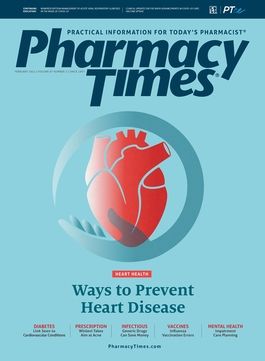Step Therapy Helps Manage Dry Eye Disease
Pharmacists can educate patients about treatment options for this often-overlooked condition.
Dry Eye Disease (DED), also known as keratoconjunctivitis sicca, is a common condition that occurs when tears don’t provide adequate lubrication for a patient’s eyes.1
Epidemiologic information about DED is limited due to lack of a standardized definition as well as diagnostic criteria. DED is often overlooked by clinicians and patients, even though it affects individuals of all ages. Americans, on average, spend $783 per year to manage DED.2
There are various signs and symptoms that can suggest DDE, such as decreased tear meniscus, fluctuating vision, mucus discharge, ocular irritation, plugged meibomian glands, or redness, according to American Academy of Ophthalmology (AAO) guidelines.3
Identifying and treating DDE is important to prevent compromised results from cataract, corneal, or refractive surgeries; discomfort; or visual disabilities.
DED can be caused or exacerbated by medications, such as α-1 antagonists, α-2 agonists, anticholinergics, anticonvulsants, antihistamines, antimalarials, antineoplastics, anxiolytics, antipsychotics, β-agonists and β-antagonists, bisphosphonates, cannabinoids, diuretics, oral contraceptives, retinoids, systemic and topical decongestants, and tricyclic antidepressants.1,3
Preservatives such as benzalkonium chloride also can cause problems. As a result, DED tends to be more common among older individuals because of polypharmacy and age-related changes.
As clinicians, it is always important to evaluate whether the benefits of certain OTC or prescription medications outweigh the risks. Pharmacists can provide value to clinical teams by offering expertise on finding therapeutic alternatives or deprescribing medications to manage DED.
AAO guidelines offer a 4-step process to effectively manage DED.
Step 1 includes nonpharmacologic strategies, such as modification of the environment or hygiene, patient education, or use of ocular lubricants.
Steps 2 to 4 include a wide range of approaches that encompass both nonpharmacologic and pharmacologic strategies. For step 2, strategies include using a limited-duration steroid, moisture chamber goggles, nonpreserved ocular lubricants, overnight treatments, prescription drugs, tea oil treatments, or a topical antibiotic. Topical cyclosporine or lifitegrast (lymphocyte function associated antigen-1 antagonist) are also options to manage DED and mitigate symptoms.1 Lifitegrast has shown efficacy over a 3-month period in treating moderate DED, but it lacks long-term (12-month) adverse effect and efficacy data.4-6
For step 3, autologous eye drops, oral secretagogues (eg, pilocarpine or cevimeline), or therapeutic contact lenses may be considered. Cevimeline and pilocarpine are cholinergic agonists that stimulate tear production as well as other salivary and sweat glands.1 Cevimeline provides additional benefits by improving ocular irritation symptoms.
Finally, step 4 may include amniotic membrane grafts, surgery, or a topical corticosteroid for an extended duration.
CONCLUSION
It is important to identify contributing factors to a patient’s DED prior to initiating step therapy. Because pharmacists can provide knowledge about drug mechanisms and/or adverse effect profiles, they can help optimize medication therapy management.
DAVID KIM, PHARMD, MPH, is the chief of pharmacy operations at the 92nd Medical Group, US Air Force. He is on military leave from the Mayo Clinic in Rochester, Minnesota.
REFERENCES
- Akpek EK, Amescua G,Farid M, et al. Dry eye syndrome preferred practice pattern. Ophthalmology. 2019;126(1):P286-P334. doi:10.1016/j.ophtha.2018.10.023
- Yu J, Asche CV, Fairchild CJ. The economic burden of dry eye disease in the United States: a decision tree analysis. Cornea. 2011;30(4):379-387. doi:10.1097/ICO.0b013e3181f7f363
- Gosser R.Drug-induced ophthalmic disorders. In: DiPiro JT, Yee GC, Posey LM, Haines ST, Nolin TD, Ellingrod V, eds. Pharmacotherapy: A Pathophysiologic Approach. 11th ed. McGraw-Hill;2020:chapter e-112.
- Sheppard JD, Torkildsen GL, Lonsdale JD, et al. Lifitegrast ophthalmic solution 5.0% for treatment of dry eye disease: results of the OPUS-1 phase 3 study. Ophthalmology. 2014;121(2):475-483. doi:10.1016/j.ophtha.2013.09.015
- Holland EJ, Luchs J, Karpecki PM, et al. Lifitegrast for the treatment of dry eye disease: results of a phase III, randomized, double-masked, placebo-controlled trial (OPUS-3). Ophthalmology. 2017;124(1):53-60. doi:10.1016/j.ophtha.2016.09.025
- Tauber J, Karpecki P, Latkany R, et al. OPUS-2 investigators. Lifitegrast ophthalmic solution 5.0% versus placebo for treatment of dry eye disease: results of the randomized phase III OPUS-2 study. Ophthalmology. 2015;122(12):2423-2431. doi:10.1016/j.ophtha.2015.08.001

